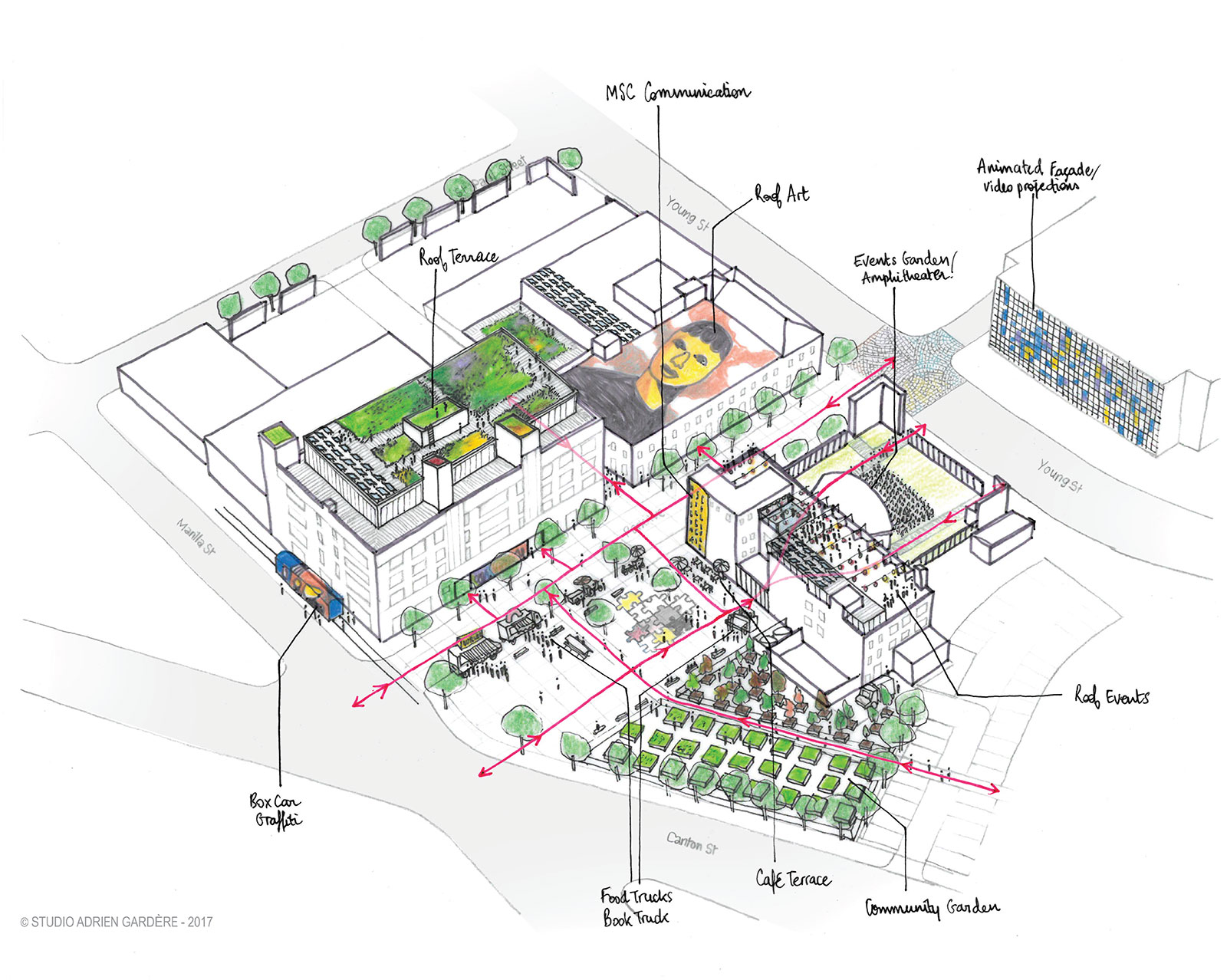An already ambitious plan to transform an often neglected corner of downtown into a hub for both cultural programming and social services has grown in size and scope, with one of its most compelling features, the Museum of Street Culture, now set to open this fall.
The team behind the Encore Park development — the centerpieces of which include the historic Warner Bros. building at 508 Park where Robert Johnson famously made half of his recordings, and the homeless support shelter the Stewpot — on Tuesday described the newly expanded concept as a sort of pioneering model for urban regeneration. A press release hailed it as “unprecedented in the nation, and, we believe, the world.”
In practical terms, this means Encore Park, already beginning to unfurl itself at the corner of Park and Young streets across from First Presbyterian Church, will grow by about 30 percent to include another building at 515 Park. It means rooftop events and art exhibits, food trucks and video projections. It means rehearsal spaces, artists’ residences, gardens, a recording studio, live performances and film screenings, and cafes. (An outdoor amphitheater and community garden, now set to extend into a planned plaza, are already in place.) It means renovations for the Stewpot, including a larger space for caseworkers and care reception, all of this connected by lively, walkable streets. It means Wi-Fi.
In more practical terms, it means Encore Park will probably need more money. A $2.1 million grant from the Moody Foundation, announced last month, put the development at about $10 million of what was an $18 million goal. Developers were reluctant to put a new price tag on the project, and after speaking with press Tuesday afternoon, the minds behind Encore Park were on their way to meet a likely more moneyed group of people.
The vision for Encore Park should be able to whip up interest and open wallets: it’s a bold plan that would stitch together downtown development around Main Street on the one side, and around the Dallas Farmers Market on the other. But it’s Encore Park’s intent to involve and serve the homeless and at-risk people who already congregate in the area, a sort of idealized gentrification without displacement, that makes the project “unprecedented,” framable as both a pragmatic real estate development and noble community undertaking.
Those lofty aspirations and Encore Park’s work-in-progress nature are perhaps each best illustrated by the Museum of Street Culture, opening this fall even as most of the historic buildings remain un-renovated. Its first show, appropriately enough, will revolve around the work of photographer Mary Ellen Mark, who spent much of her career documenting the lives of homeless and impoverished Americans. (The museum will also partner with the Nasher for programming beginning in 2018, and further collaborations are in the works with the Dallas Museum of Art, Latino Cultural Center, and African American Museum.)
The unfinished renovations will force the museum to adapt the exhibition, including forums and film screenings, to what space exists, and in a way helps drive home the point that the museum is not defined by its buildings: it was at one point described Tuesday as having the potential to be a “think tank” for issues of homelessness and displacement.
Much of this expanded vision, as well as the Museum of Street Culture, can be attributed to French museum designer Adrien Gardère, who has been a consultant on Encore Park from its inception and was officially brought on board the planning team last month. Gardère previously designed a branch of the Louvre that opened in an impoverished town in northern France in 2012. That experiment in bringing an ambitious cultural institution to a depressed area appears to have been a success, with the Louvre-Lens receiving 1.5 million visitors in 2014, although Encore Park could possibly be a more complex undertaking.
Gardère spoke admiringly of the “hobo” as a classic American figure, conjuring a poetic image, supported by designs that call for two boxcars to be installed next to the old railroad siding on Canton Street. That whimsical idea seems to do a slight disservice to the very real and decidedly un-romantic problems of poverty and mental illness faced by the neighborhood’s homeless population, but there’s no other reason to think that Gardère — or the developers and First Presbyterian leaders involved with the design — have any illusions about the challenges Encore Park faces.
Stewpot clients have themselves been consulted on the project, and should eventually make up a significant part of Encore Park’s staff. Through the Stewpot’s art program, they’ll also be responsible for much of the neighborhood’s art and culture. In theory, they’re the people who should get the most from Encore Park. In its ideal form, Encore Park will grow existing social services and integrate them with new cultural programs, bringing an all too frequently overlooked community into close contact with the rest of the city.






